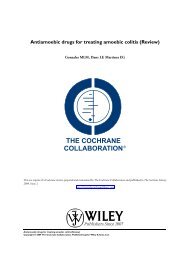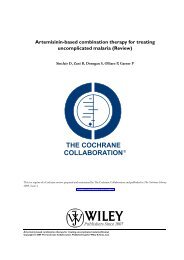Interventions for treating proximal humeral fractures in adults (Review)
Interventions for treating proximal humeral fractures in adults (Review)
Interventions for treating proximal humeral fractures in adults (Review)
Create successful ePaper yourself
Turn your PDF publications into a flip-book with our unique Google optimized e-Paper software.
A development of the Cochrane Bone, Jo<strong>in</strong>t and Muscle Trauma<br />
Group quality assessment tool (see Group details) was used <strong>in</strong><br />
the evaluation of all the <strong>in</strong>cluded trials. At m<strong>in</strong>imum, two review<br />
authors <strong>in</strong>dependently assessed each paper, without mask<strong>in</strong>g of<br />
journal sources, authors and support<strong>in</strong>g <strong>in</strong>stitutions. Table 1 shows<br />
the scor<strong>in</strong>g scheme based on 11 aspects of trial methodology. From<br />
the fourth update (Issue 2, 2007) of this review, the scores of the<br />
<strong>in</strong>dividual items <strong>for</strong> each trial were no longer summed.<br />
Table 1. Methodological quality assessment scheme<br />
Items Scores Notes<br />
1. Was the assigned treatment adequately<br />
concealed prior to allocation?<br />
2. Were the outcomes of trial participants<br />
who withdrew described and <strong>in</strong>cluded <strong>in</strong><br />
the analyses, and all participants analysed<br />
accord<strong>in</strong>g to the group allocated at randomisation<br />
(<strong>in</strong>tention to treat)?<br />
3. Were the outcome assessors bl<strong>in</strong>ded to<br />
treatment status?<br />
4. Were important basel<strong>in</strong>e characteristics<br />
reported and comparable?<br />
5. Were the trial participants bl<strong>in</strong>d to assignment<br />
status after allocation?<br />
6. Were the treatment providers bl<strong>in</strong>d to<br />
assignment status?<br />
3 = method did not allow disclosure of assignment.<br />
1 = small but possible chance of disclosure<br />
of assignment or unclear.<br />
0 = quasi-randomised or open list/tables.<br />
3 = withdrawals well described and accounted<br />
<strong>for</strong> <strong>in</strong> analysis.<br />
1 = withdrawals described and analysis not<br />
possible.<br />
0 = no mention, <strong>in</strong>adequate mention, or<br />
obvious differences and no adjustment.<br />
3 = effective action taken to bl<strong>in</strong>d assessors.<br />
1 = small or moderate chance of unbl<strong>in</strong>d<strong>in</strong>g<br />
of assessors, or some bl<strong>in</strong>d<strong>in</strong>g of outcomes<br />
attempted.<br />
0 = not mentioned or not possible.<br />
3 = good comparability of groups, or confound<strong>in</strong>g<br />
adjusted <strong>for</strong> <strong>in</strong> analysis.<br />
1 = confound<strong>in</strong>g small, mentioned but not<br />
adjusted <strong>for</strong>, or comparability reported <strong>in</strong><br />
text without confirmatory data.<br />
0 = large potential <strong>for</strong> confound<strong>in</strong>g, or not<br />
discussed.<br />
3 = effective action taken to bl<strong>in</strong>d participants.<br />
1 = small or moderate chance of unbl<strong>in</strong>d<strong>in</strong>g<br />
of participants.<br />
0 = not possible, not mentioned, or possible<br />
but not done.<br />
3 = effective action taken to bl<strong>in</strong>d treatment<br />
providers.<br />
1 = small or moderate chance of unbl<strong>in</strong>d<strong>in</strong>g<br />
of treatment providers.<br />
<strong>Interventions</strong> <strong>for</strong> <strong>treat<strong>in</strong>g</strong> <strong>proximal</strong> <strong>humeral</strong> <strong>fractures</strong> <strong>in</strong> <strong>adults</strong> (<strong>Review</strong>)<br />
Copyright © 2008 The Cochrane Collaboration. Published by John Wiley & Sons, Ltd.<br />
Cochrane code (see Handbook): Clearly<br />
Yes = A; Not sure = B; Clearly no = C.<br />
The pr<strong>in</strong>cipal confounders were considered<br />
to be age, gender and type of fracture.<br />
5








